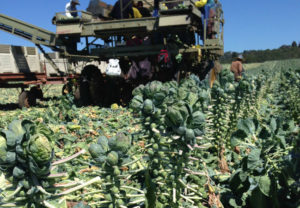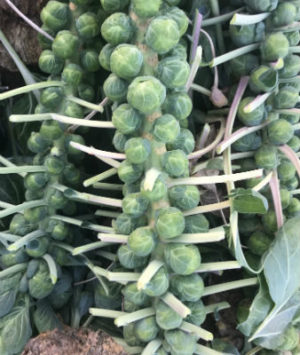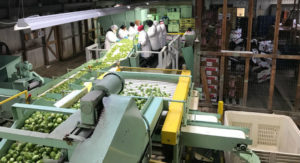Brussels sprouts demand increases dramatically in under a decade
Talk to people in the Brussels sprouts business and they all tend to say the same thing.
“About five to seven years ago,” most begin, and then go on to tell a story of how a growing uptick in demand for Brussels sprouts as a commodity surfaced around that time. Some say it started with cooking shows. Then restaurants took notice, adding them to menus.
Brussels sprouts are a member of the same family as kale, broccoli and cauliflower, and so their health benefits have also come to be touted. The USDA National Nutrient Database reports that Brussels sprouts provide substantial amounts of vitamin A, vitamin C, folic acid and fiber.

“Brussels are undergoing a renaissance,” said Jacob Shafer, spokesman for Mann’s. “The rise is, in some ways, connected to recent research stating Brussels sprouts are as rich a source of many nutrients compared with kale.”
On the other hand, said Charlie Eagle, bacon might get some of the credit. He’s the vice president of business development for Florida-based Southern Specialties, which offers value-added peeled and ready to microwave Brussels sprouts under its Southern Selects label.
“Somewhere down the road a couple of celebrity chefs said, ‘Man, you’ve got to taste these Brussels sprouts when you pair them with bacon’ and people went wild for it,” Eagle said. “We started to see a lot of Brussels sprouts in restaurants, and when people experience it in restaurants, the next thing, they’re going to retail shelves and trying to replicate those taste profiles.
“Really, the bacon and Brussels sprouts thing has been a pretty good contributor (to Brussels sprouts’ popularity).”
Whatever the reason, the once nearly-reviled and only trotted out at Thanksgiving and maybe Christmas Brussels sprout has become cool.
“According to the U.S. Department of Agriculture’s Retail Report, Brussels sell best on promotion around Thanksgiving and Christmas, but promotions during other parts of the year are on the rise, too,” Shafer said. “The study found the average number of stores with Brussels on promotion in 2016 increased 70 percent from just three years prior, from 462 per week in 2013 to 787 per week.”
That means acreage is up as growers struggle to meet increasing demand for fresh as well as value-added and processed Brussels sprout products.

In fact, Steve Bontadelli, general manager of Brussels sprouts grower, packer and shipper Pfyffer Associates in Santa Cruz, California, said demand from processors has “grown tenfold.”
“It’s done a complete 180 over the last five years,” Bontadelli said.
In the 1960s, Bontadelli estimates, about 7,000 acres of Brussels sprouts were being grown in California, mostly for frozen processing. That number fell to a low point of around 2,200 acres.
“Now we’re up over 10,000 in California, and more in Mexico,” he said. And where it used to be that the crop went to 80 percent frozen and
20 percent fresh, that’s flip-flopped. “Now it’s about 15 percent frozen and 85 percent fresh because of demand,” Bontadelli said. “And we’re getting more money for the fresh because we can’t meet demand.”
It used to be that demand came mainly from the northeastern part of the U.S. and in Canada, he adds. No more.
“Now we sell them everywhere,” he said. “I’ve got a guy in Florida that processes them … we never used to sell a Brussels sprout in Florida.
“Guys are coming out of the woodwork.”
Bontadelli said one processor of pickled Brussels sprouts in Arkansas used to order 4,000 pounds every year or year and a half.
“Now I’m giving them to him every other week,” Bontadelli said. “He can’t keep them on the shelf.”
That would be Bryant Preserving Company in Alma, Arkansas. President Morgan Bryant said that his company has been pickling Brussels sprouts for several years, but estimates sales are up about 20 percent. Besides offering them in hot and mild varieties at retail in 16-ounce jars, they sell the pickled Brussels sprouts in cases of six No. 10 cans for foodservice. Some of those end up in salad bars in places like Whole Foods.
“It’s definitely up from what it was a few years ago,” he said.
Brussels sprouts are showing up in prepared fresh-cut salads, sometimes shredded chiffonade style or sliced and mixed with other ingredients. Bontadelli said it’s common to see them cut in half, seasoned and wrapped in trays, ready to sauté or roast in the oven.
Apio’s Eat Smart brand offers a Sweet Kale Salad Kit that includes kale, green cabbage and Brussels sprouts along with chicory, pumpkin seeds and dried cranberries and dressing. It also produces ready-to-cook, trimmed Brussels sprouts by the bag.
Los Angeles Salad Company packages washed and trimmed Brussels sprouts in microwaveable 8-ounce, 12-ounce and 2-poundbags.
Mann’s features a single-serving Nourish Bowl with bacon, Brussels sprouts, kohlrabi, and kale tossed in a sweet maple glaze. Its Culinary Cuts Shaved Brussels Sprouts are designed for sautéing or cooking with other ingredients or suggested as a replacement in cole slaw and other recipes that call for cabbage. A Mann’s Super Food Power Blend includes Brussels sprouts with cabbage, kohlrabi, broccoli, carrots and kale to be blended into a smoothie, tossed in a salad or used in cooking. It also offers washed and trimmed Brussels sprouts in a microwave-safe, steamable bag.
“We see Brussels doing really well in the value-added space,” Shafer said.

So does Southern Specialties, which sells most of its Brussels sprouts in value-added formats.
“We try and match our packaging to consumers needs,” Eagle said. “We actually started our Brussels sprout program with a hand-peeled Brussels sprout that was ideal for a microwaveable pack.
“We’ll go anywhere from an 8-ounce microwaveable Brussels sprout offering in a top-seal tray as well as larger formats that would be 1 to 2 pounds that are ideal for either the retail store or club store format.”
In fact, club stores account for a lot of the demand, said Frank Costella, former owner of Moseo Produce and now a consultant for Boggiatto Produce, a grower-shipper in Salinas that counts Brussels sprouts among its products.
“We sell to companies that package for Costco, Walmart, Sam’s Club and those companies,” Costella said. “That’s where there has been a very large increase in demand.”
Also, it used to be that there wasn’t much market for the very largest, or jumbo, Brussels sprouts. Sometimes they even got thrown away for lack of interest by buyers.
“They were kind of a by-product,” Costella said. “But now there is a definite increase in demand for the jumbos. Shredding has definitely increased and the market for them has increased as well.”
Where it goes from here is hard to say if demand continues to grow. Brussels sprouts are difficult to grow and take a certain kind of cool coastal climate to thrive – in California, mainly, along with some areas of Canada and in Mexico, Costella said.
“It’s hard to increase the supply,” he said, “because you can’t grow them everywhere.”
— Kathy Gibbons, contributing writer







